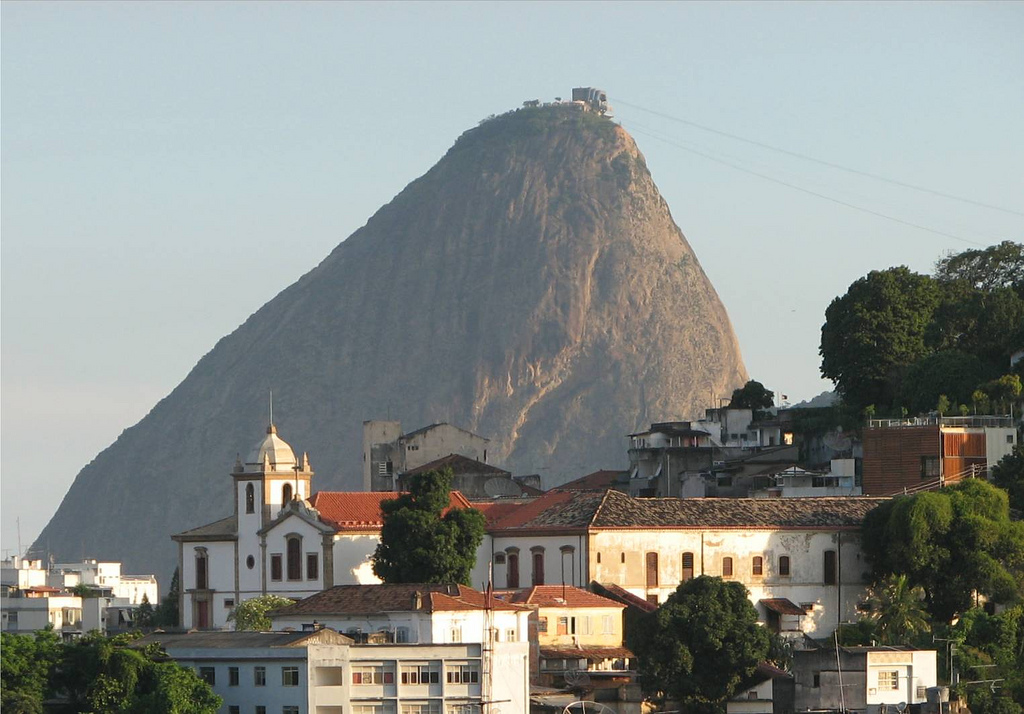
The scenic Santa Teresa neighborhood in Rio de Janeiro city. Photo © Cyro A. Silva, licensed Creative Commons Attribution.
It would be a shame to come to Rio de Janeiro and not visit the utterly charming, bucolic hilltop neighborhood of Santa Teresa, one of the city’s oldest residential bairros. In the 19th century, wealthy Cariocas built gracious villas along its narrow winding streets, with terraces and balconies overlooking the lush green mountains and blue waters of the Baía de Guanabara. The views are still alluring—as is the neighborhood, which is why after a long period of decline many artists began to move in, snatching up the dilapidated villas for a song and transforming them into ateliers and galleries. After an initial revival in the 1960s and 1970s, a second revitalization began to take place in 2005, resulting in the trickling in of boutique hotels and fashionable bistros as well as improved security (surrounded by favelas, Santa Teresa has traditionally had a somewhat questionable reputation, particularly at night). Thanks to efforts spearheaded by neighborhood artists, Santa Teresa has gradually evolved into a vibrant community.Thanks to efforts spearheaded by neighborhood artists, Santa Teresa has gradually evolved into a vibrant community. Many small-scale artistic and musical events take place in “Santa” on a regular basis. Among the most popular is an event known as Portas Abertas. Held twice a year—on weekends in May and November—Santa Teresa’s “Open Doors” event involves over 100 resident artists, who literally open the doors to their homes and studios so you can view their work (and their often fantastic living spaces).The easiest, and by far most diverting, way to get to Santa Teresa is to hop aboard the old-fashioned bonde (trolley) that clangs its way up the hills from Centro. Bondes leave from the Estação Carioca (Rua Professor Lélio Gama, tel. 21/2240-5709, departures every 20 minutes 6 a.m.–10 p.m. daily, R$1), located near the Carioca Metrô station. The ride itself is wonderfully scenic; the bonde passes over the Arcos da Lapa before climbing up the steep hills of Santa Teresa, continuing until it finally clatters to a halt at the charming Largo dos Guimarães. Although security on the open-sided bondes has been beefed up, keep visible valuables to a minimum.
The Museu Chácara do Céu (Rua Murtinho Nobre 93, tel. 21/2224-8981, noon–5 p.m. Wed.–Mon., R$2, free Wed.) is among Rio’s loveliest museums. Surrounded by a beautiful hilltop garden designed by noted landscaper Roberto Burle Marx, the museum is located in an attractive modernist house built in 1957 by Raimundo Castro Maia, a wealthy business magnate with a great eye for art. His impressive private collection includes the works of some fine Brazilian masters, such as Alberto da Veiga Guignard, Emiliano Di Cavalcanti, and Cândido Portinari. Also exhibited are sketches and paintings of Brazil created by visiting Europeans, most notably Jean-Baptiste Debret, a French painter whose watercolors portray 19th-century Cariocas from all walks of life. The international collection took a serious hit during Carnaval in 2006, when thieves entered the museum and made off with a Monet, a Picasso, a Matisse, and a Dalí in broad daylight.
Adjacent to the museum is the Parque das Ruínas (Rua Murtinho Nobre 169, tel. 21/2252-1039, 8 a.m.–8 p.m. Tues.–Sun.), a small but leafy park built around the atmospheric ruins of a palace that belonged to Laurinda Santos Lobo, a wealthy Carioca who was a generous patron of the arts during the early 1900s. Today, its renovated remains house a cultural center that features art exhibits. A small café offers magnificent views of Pão de Açúcar and Corcovado.
Excerpted from the Third Edition of Moon Brazil.